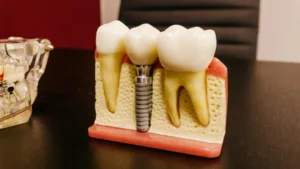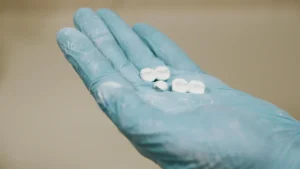Temporary dental crowns are interim caps placed over a tooth to protect it while waiting for a permanent crown. These crowns, often made of acrylic or metal, help maintain normal function and safeguard your gums and teeth.
In this article, you’ll discover:
- When temporary crowns are needed
- Materials used
- How to care for them
Stay informed and ensure your dental health remains optimal!
What Are Temporary Dental Crowns?
Temporary dental crowns act as a protective device for your tooth while a permanent crown is being crafted. At My New Tooth, we understand that maintaining dental health during this interim period is crucial. These crowns, though temporary, offer necessary protection, ensuring you can perform daily activities without major disruptions.
Purpose and Function of Temporary Dental Crowns
Temporary crowns serve several purposes:
- Protection: They protect the tooth and gums from damage and bacterial infection.
- Functionality: They allow you to eat, drink, and speak normally.
- Aesthetics: They provide an acceptable appearance while waiting for the permanent crown.
Although temporary crowns are not as durable or customized as permanent ones, they are crafted to fit adequately and maintain the functionality of the tooth they cover.
Materials Used in Temporary Dental Crowns
Temporary crowns can be made from various materials, each serving different needs and preferences.
- Acrylic: These are the most common due to their ease of use and cost-effectiveness. Acrylic crowns are typically used for short-term purposes.
- Metal: Stainless steel crowns are often used, especially for molars. They are more durable but less aesthetically pleasing.
- Composite: These offer a balance between strength and appearance, making them a versatile option.
How Temporary Dental Crowns Are Made
Creating a temporary crown involves a few simple steps:
- Initial Appointment: Your dentist will first take an impression of your tooth to create a mold.
- Tooth Preparation: The tooth is reshaped to make room for the crown.
- Fabrication: The temporary crown is crafted using the mold, typically within the same appointment.
- Placement: Once the crown is made, the dentist will place and adjust it to fit comfortably.
Benefits of Temporary Dental Crowns
Temporary dental crowns come with several advantages:
- Immediate Protection: They protect the exposed tooth and surrounding gums.
- Interim Solution: They allow you to function normally while waiting for a permanent solution.
- Ease of Placement: The process of fitting a temporary crown is relatively quick and straightforward.
When Are Temporary Dental Crowns Needed?
Temporary dental crowns are essential in various dental procedures. They are most commonly used after treatments that leave the tooth vulnerable or while waiting for lab-crafted permanent crowns.
Post-Root Canal Treatments
After a root canal, the tooth can become fragile. Temporary crowns provide protection and stability during the healing process.
Broken or Damaged Teeth
If you have a tooth that is cracked or severely decayed, a temporary crown can protect it from further damage while a permanent crown is being made.
Dental Implants
When receiving a dental implant, the process usually takes multiple visits. Temporary crowns help maintain the appearance and function of your teeth during the interim period.
Cosmetic Adjustments
For those undergoing cosmetic dental procedures, temporary crowns can help you transition smoothly without compromising aesthetics.
Materials Used for Temporary Dental Crowns
The choice of material for a temporary crown depends on the location of the tooth, the duration for which the crown will be needed, and personal preference.
Acrylic Crowns
Acrylic is widely used due to its affordability and ease of customization. These crowns are ideal for short-term use and provide a reasonable aesthetic match.
Stainless Steel Crowns
Stainless steel crowns are durable and are often used for molars. These crowns can withstand the pressure of chewing and are an excellent choice for temporary crowns that need to last longer.
Composite Crowns
Composite crowns offer a middle ground between strength and appearance. They are versatile and can be color-matched more closely to your natural teeth, making them a popular option for front teeth.
The Procedure of Getting a Temporary Dental Crown
Getting a temporary dental crown involves several steps that ensure the crown fits well and functions properly.
Initial Consultation
Your dentist will evaluate the condition of the tooth and discuss the need for a temporary crown. An impression of your tooth will be taken to create an accurate mold.
Tooth Preparation
The affected tooth is reshaped to make room for the crown. This may involve removing any decayed or damaged parts of the tooth.
Fabrication of the Crown
The temporary crown is crafted using the mold of your tooth. This process usually happens quickly to ensure you are not left without a protective covering.
Placement and Adjustment
Once the crown is ready, your dentist will place it over the prepared tooth. Adjustments are made to ensure a comfortable fit and proper alignment with your other teeth. The crown is secured with a temporary adhesive.
How Long Do Temporary Dental Crowns Last?
Temporary dental crowns are designed for short-term use. They typically last anywhere from a few days to a few weeks, depending on the materials used and the care taken.
Duration Factors
- Material Quality: Higher-quality materials like composite may last longer than acrylic.
- Dental Hygiene: Proper care and hygiene can extend the life of the temporary crown.
- Location of the Crown: Crowns on molars may wear out faster due to the pressure from chewing.
Maintenance Tips
To ensure the longevity of your temporary crown:
- Avoid Hard Foods: Hard or sticky foods can dislodge or crack the crown.
- Maintain Hygiene: Brush and floss gently around the crown.
- Regular Check-ups: Follow up with your dentist for any necessary adjustments.
Appearance and Aesthetics of Temporary Dental Crowns
While the primary function of temporary dental crowns is protection, aesthetics also play a role, especially if the crown is in a visible location.
Matching Your Natural Teeth
Temporary crowns are usually made to match your natural tooth color, though they may not be as precisely color-matched as permanent crowns. The aim is to provide an acceptable appearance during the waiting period.
Cosmetic Considerations
- Front Teeth: Temporary crowns on front teeth are crafted to look more natural and blend with your smile.
- Adjustments: Minor adjustments can be made to improve fit and appearance, but keep in mind they are not a final solution.
Limitations
Although temporary crowns are designed to be aesthetically pleasing, they may not perfectly match the natural look and feel of a permanent crown. However, they serve their purpose effectively while providing a reasonable appearance.
This concludes this portion of the article. You can refer to the rest of the sections for comprehensive insights on temporary dental crowns.
Eating and Drinking with Temporary Dental Crowns
When you have temporary dental crowns, modifying your eating and drinking habits helps protect the crown and minimize discomfort. At My New Tooth, we offer these recommendations to maintain your dental health during this interim period.
Foods to Avoid
Certain foods can damage or dislodge temporary crowns:
- Hard foods: Avoid nuts, hard candies, and raw vegetables which can cause the crown to crack.
- Sticky foods: Caramel, gum, and sticky candies can pull the crown off.
- Chewy foods: Tough meat and crunchy bread may put undue pressure on the crown.
Recommended Diet
Adopt a diet that minimizes risks:
- Soft foods: Mashed potatoes, yogurt, eggs, and soft-cooked vegetables are ideal.
- Cut food into small pieces: This reduces the need for heavy chewing and places less strain on the crown.
Drinking Considerations
While your temporary crown is in place, be mindful of your drinking habits:
- Avoid very hot or cold drinks: Extreme temperatures can cause sensitivity.
- Limit sugary beverages: Sugary drinks can increase the risk of decay around your temporary crown.
Maintaining proper eating and drinking habits helps ensure your temporary crown stays intact and continues to safeguard your dental health.
Caring for Temporary Dental Crowns
Caring for your temporary dental crown ensures it remains functional and protects your tooth effectively. Follow these guidelines to maintain it properly.
Oral Hygiene Practices
Maintain your usual dental hygiene routine but with some adjustments:
- Gentle brushing: Brush your teeth twice a day, focusing on gentle strokes around the crown.
- Floss carefully: Slide the floss instead of pulling it up, to avoid dislodging the crown.
- Mouthwash use: Antibacterial mouthwash can help maintain oral hygiene without affecting the crown.
Protective Measures
Adopt these habits to protect your crown:
- Avoid using teeth as tools: Using your teeth to open packages or bottles can damage the crown.
- Wear a mouthguard: If you grind your teeth at night, a mouthguard can prevent damage to the crown.
Regular Dental Visits
Schedule regular follow-up appointments for adjustments and check-ins:
- Regular check-ups: Ensure your crown fits well and there are no issues before your permanent crown is ready.
By adopting these care practices, you can extend the life and function of your temporary dental crown.
What to Do If a Temporary Crown Falls Off
A temporary crown can sometimes fall off, especially if not handled carefully. Here’s what you should do if that happens.
Immediate Actions
If your temporary crown falls off, follow these steps:
- Retrieve the crown: Keep it safe and clean.
- Inspect your tooth: Look for any damage or sharp edges.
- Contact your dentist: Call us immediately to schedule an appointment for reattachment.
Temporary Fixes
While waiting to see your dentist, you can take these temporary measures:
- Dental cement: Available over-the-counter, it can temporarily secure the crown in place.
- Avoid certain foods: Stick to soft foods and avoid chewing on the affected side.
Preventing Recurrence
To prevent your temporary crown from falling off again:
- Follow care guidelines: Maintain proper hygiene and avoid risky foods.
- Use caution: Be mindful of chewing and biting pressures.
Taking quick action and preventive measures ensures minimal disruption to your dental health.
Potential Issues with Temporary Dental Crowns
While temporary dental crowns are effective, you may face some common issues. Knowing these potential problems and how to address them is beneficial.
Sensitivity and Discomfort
You might experience tooth sensitivity or discomfort:
- Temperature sensitivity: Avoid extremely hot or cold foods and drinks.
- Mild pain: Over-the-counter pain relievers can help alleviate discomfort.
Loose Crown
A loose temporary crown can cause concern:
- Movement during eating: Be cautious with your diet and chewing habits.
- Check with your dentist: Regularly ensure the crown is secure and adjust as needed.
Gum Irritation
Gum irritation can occur around the temporary crown:
- Swelling and redness: Rinse with warm salt water to soothe gums.
- Proper hygiene: Ensure gentle brushing and flossing to avoid further irritation.
Addressing these issues promptly helps maintain the effectiveness of your temporary dental crown.
Temporary Crown Removal and Permanent Crown Placement
Transitioning from a temporary to a permanent crown is a crucial step in your dental treatment. Here’s what to expect during this process.
Removal of Temporary Crown
Removing the temporary crown involves these steps:
- Numbing the area: Your dentist will provide local anesthesia to ensure comfort.
- Careful removal: Special tools are used to loosen and remove the temporary crown without damaging the underlying tooth.
Preparation for Permanent Crown
Preparation for placing the permanent crown includes:
- Cleaning and inspection: The tooth and surrounding gums are cleaned and examined for any issues.
- Fitting the permanent crown: Adjustments ensure a perfect fit before securely placing the crown with dental cement.
Final Adjustments
Once the permanent crown is in place:
- Bite check: Your dentist will ensure your bite feels natural and comfortable.
- Polishing and smoothing: The crown is polished to a smooth finish, matching the appearance of your natural teeth.
This procedure completes your dental restoration, providing long-term protection and aesthetic improvement.
Cost Considerations for Temporary Dental Crowns
Understanding the cost aspects of temporary dental crowns can help you make informed decisions. Here’s a breakdown of what influences the cost and available options.
Factors Influencing Cost
Several factors can impact the overall cost of temporary dental crowns:
- Material used: Acrylic is generally less expensive than composite or metal.
- Tooth location: Crowns for molars might be more costly due to durability requirements.
- Dentist’s expertise: Highly experienced dentists may charge more for their services.
Typical Cost Range
On average, temporary dental crowns can vary in cost:
- Acrylic crowns: Lower cost, typically ranging from $100 to $250.
- Composite or metal crowns: Can range from $200 to $400, depending on complexity and material.
Insurance and Payment Options
Explore these options to manage expenses:
- Insurance coverage: Check with your provider to determine if temporary crowns are covered.
- Payment plans: Many dental clinics offer payment plans to spread the cost over time.
- Discount programs: Look for dental savings programs that can reduce out-of-pocket expenses.
Understanding the cost considerations helps you plan effectively for your dental treatment.
Conclusion: Key Takeaways on Temporary Dental Crowns
Temporary dental crowns play a crucial role in protecting your teeth during dental procedures. They provide immediate protection, maintain functionality, and offer an acceptable aesthetic appearance while awaiting your permanent crown. Careful maintenance and adjustments by your dentist ensure they remain effective and comfortable.
By following the recommended care guidelines and addressing any issues promptly, you can ensure a smooth transition to your permanent dental crown, maintaining your dental health and overall well-being.




